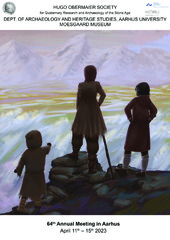Приказ основних података о документу
Settlement patterns in the Balkan Peninsula during MIS 3
| dc.creator | Plavšić Gogić, Senka | |
| dc.creator | Dragosavac, Sofija | |
| dc.creator | Radović, Predrag | |
| dc.creator | Mihailović, Bojana | |
| dc.creator | Mihailović, Dušan | |
| dc.creator | Dogandžić, Tamara | |
| dc.date.accessioned | 2023-11-29T22:07:54Z | |
| dc.date.available | 2023-11-29T22:07:54Z | |
| dc.date.issued | 2023 | |
| dc.identifier.isbn | 978-3-946387-51-0 | |
| dc.identifier.uri | http://reff.f.bg.ac.rs/handle/123456789/5521 | |
| dc.description.abstract | The Marine Isotope Stage 3 (MIS 3) is characterized by signifcant climatic changes associated with abrupt atmospheric shifts over Greenland (Dansgaard-Oeschger events) and episodes of massive iceberg discharge into the North Atlantic (Heinrich events), enhancing cold and dry conditions at mid-to-low latitudes. The extreme conditions and fuctuating climatic and environmental conditions of Marine Isotope Stage 3 signifcantly afected many aspects of the lives of prehistoric populations, including settlement and mobility patterns. Many ethnographic studies show that settlement and mobility patterns are conditioned by numerous factors such as climate conditions, terrain morphology, group preferences, animal behavior, resource availability, etc. Although the Balkan peninsula has been characterized as a refugial region, hominine populations could still be afected by the unstable conditions of Marine Isotope Stage 3. With extensive research conducted during the last few decades in the Balkan peninsula, available data shows mostly diverse practiced settlement models during MIS 3. This study aims to examine settlement and mobility patterns of the hominine groups during Marine Isotope Stage 3 on the Balkan peninsula with a specifc accent on the factors that could have infuenced them. The study is based on published data from the Middle and Upper Paleolithic sites in the Balkan peninsula, dated to Marine Isotope Stage 3. We consider several parameters to assess the settlement and mobility patterns of the hunter-gatherer groups. Two analyses have been conducted: bivariate WABI (Whole assemblage behavior index) and multivariate PCA (Principal component analysis) for the following variables: lithic density, retouched frequency, core, blanks, and chips frequency as well as tool diversity, which are frequently used to assess settlement patterns of prehistoric human populations. Including both Middle and Upper Paleolithic sites, diferences in the settlement patterns are inspected between diferent hominine populations (Neanderthals and Anatomically Modern Humans), climate conditions, and between microregions in which sites are located in. | sr |
| dc.language.iso | en | sr |
| dc.publisher | Hugo Obermaier society, Aaarhus University, Moesgaard Museum | sr |
| dc.rights | openAccess | sr |
| dc.rights.uri | https://creativecommons.org/licenses/by/4.0/ | |
| dc.source | 64th Annual Meeting in Aarhus April 11th-15th 2023, Hugo Obermaier Society for Quaternary Research and Archaeology of the Stone Age | sr |
| dc.subject | Marine Isotope Stage 3 (MIS 3) | sr |
| dc.title | Settlement patterns in the Balkan Peninsula during MIS 3 | sr |
| dc.type | conferenceObject | sr |
| dc.rights.license | BY | sr |
| dc.citation.epage | 76 | |
| dc.citation.spage | 75 | |
| dc.identifier.fulltext | http://reff.f.bg.ac.rs/bitstream/id/14015/bitstream_14015.pdf | |
| dc.identifier.rcub | https://hdl.handle.net/21.15107/rcub_reff_5521 | |
| dc.type.version | publishedVersion | sr |

